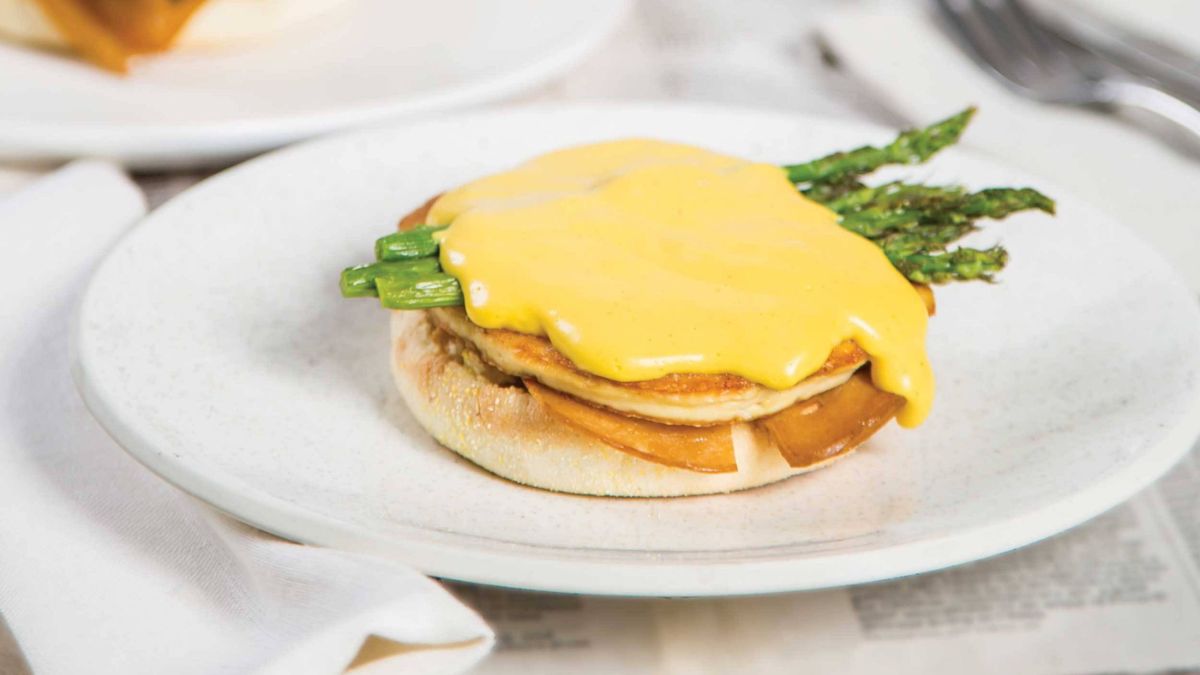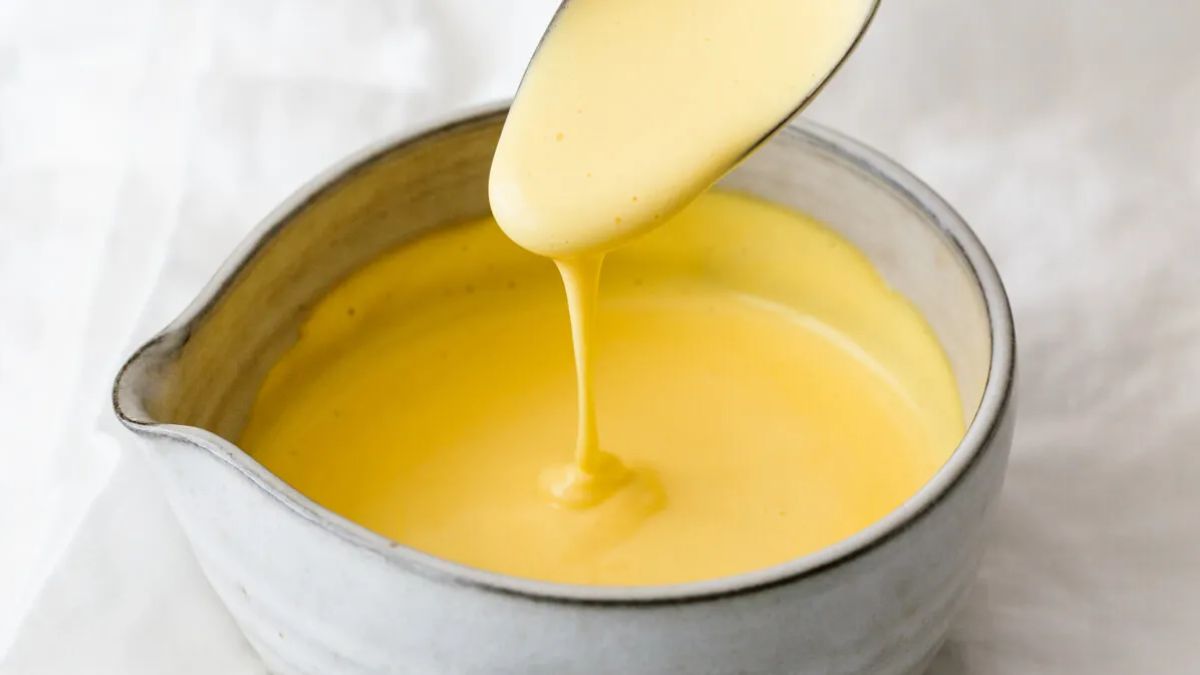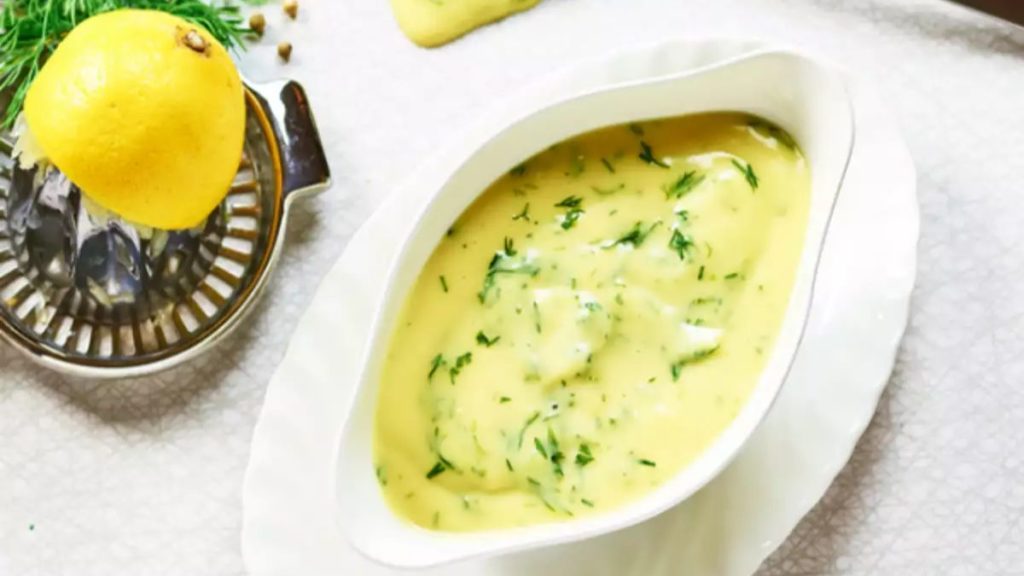Hollandaise sauce is emulsified butter, egg yolks, lemon juice, and salt. While it’s occasionally used to coat poached fish or asparagus, it’s arguably best known as the finishing touch on a plate of eggs Benedict, a brunch favourite. Sadly, as tasty as eggs Benedict can be, Eater reports that hollandaise sauce is notorious for causing food poisoning since the egg yolks aren’t fully cooked before serving. The sauce isn’t kept at a temperature high enough to kill bacteria.
As a result, many restaurant servers urge diners to stay away from eggs benedict on their favourite brunch menus unless the restaurant is producing enough eggs benedict to ensure that the hollandaise sauce doesn’t sit around for too long.
What is Hollandaise Sauce?
The Hollandaise sauce is one of the five mother sauces in French cuisine. It’s used in various meals and goes especially well with vegetables, meats, and fish. Most people are familiar with hollandaise sauce as the sauce is frequently served with eggs Benedict. Of course, one of the main reasons people are constantly asking if it’s okay to freeze hollandaise sauce is because it’s so difficult to make. It entails starting from scratch with an acid reduction, then filtering and clarifying the butter. It’s a long and involved procedure that requires a lot of whisking and your undivided attention.
Hollandaise is a sauce made from an oil-in-water emulsion. Egg yolk, melted butter, and lemon juice are the essential ingredients. Some recipes, however, substitute vinegar or a white wine reduction for lemon juice. The flavours are then rounded out with seasonings like salt, white pepper, and cayenne pepper. Two elements stick out right away: egg yolk and butter. As you are surely aware, these two ingredients must be stored carefully to avoid spoilage. Their presence in hollandaise sauce, of course, makes it extremely sensitive.
Why is Hollandaise Sauce so Unhealthy?
A word about the food safety of hollandaise sauce. There is always the risk of foodborne illness when using raw eggs. Use pasteurized eggs or cook the eggs to at least 165 degrees Fahrenheit to kill any bacteria; however, this may scramble the eggs. Egg yolks begin to thicken at about 149F (65C) and begin to curdle around 160-170F (yolks completely curdle at 185F) (85C). If you use a stride to make the sabayon, the acid gives you some leeway and prevents the yolks from coagulating if they are slightly overcooked.
Keep Hollandaise at 120°F to 145°F to avoid splitting or curdling (49C to 63C). The eggs may overcook, become gritty, and the sauce may split if the sauce is heated above 150 degrees Fahrenheit. Holding Hollandaise at this temperature allows bacteria to multiply quickly, contaminating the sauce and making it unsafe to eat, especially if it is kept for an extended time. Because Hollandaise shouldn’t be held for more than 1.5 hours, make only as much as you’ll need and never mix old and new batches of sauce.
Is Hollandaise Sauce Fattening?
Hollandaise sauce has 85 calories per 16 g serving. This serving contains 9.1 g of fat, 0.9 g of protein, and 0.3 g of carbs. The rest comprises complex carbohydrates, including 0.1 grams of sugar and 0 grams of dietary fibre. Hollandaise sauce has 5.4 grammes of saturated fat and 73 milligrammes of cholesterol per serving.
Storing Hollandaise Sauce Properly
Before serving, keep your freshly produced hollandaise sauce warm. Keep it out of the danger zone between 40 and 140 degrees Fahrenheit (4 and 60 degrees Celsius). As you may be aware, this is the temperature at which bacteria multiply the fastest.
At the same time, the sauce should be consumed within 2 hours at the most. Otherwise, we recommend storing and saving your leftover hollandaise sauce to avoid wasting it. You have two choices: you can either store it in the refrigerator or the freezer.
Refrigerating Hollandaise Sauce
If you want your hollandaise sauce to stay longer, keep it refrigerated, and it can be kept in the fridge for up to two days if done correctly. So, to correctly keep your hollandaise sauce, make sure to follow the steps indicated below.
To refrigerate hollandaise sauce, follow these steps:
- Prepare a big mixing bowl or a freezer-safe bag.
- Pour the surplus hollandaise sauce into your container of choice with care.
- If you’re using a bowl, gently set the lid on top to create a secure closure. Otherwise, secure the bag’s seal.
- Look for an area in the refrigerator that is free of food.
- Refrigerate the sauce for one to two days before serving.
Freezing Hollandaise Sauce
Freezing your hollandaise sauce is another great method to keep it fresh. Contrary to popular belief, Hollandaise freezes beautifully. This strategy allows you to make greater batches of food ahead of time. Then, when the need arises, you can proceed to heat the sauce. This allows you to approach some foods that conveniently call for this type of sauce.
Before doing anything else, make sure you have an ice cube or freezer tray available and a freezer-safe bag. These will be useful in the future. Because you’re going to the trouble of freezing the sauce, we recommend making a larger batch than usual. This way, you’ll be able to get the most out of the time you spend freezing.
follow these steps closely when freezing hollandaise sauce:
- The first step is to divide your sauce into individual pieces, and this is where the freezer tray comes in handy.
- Pour the sauce into the tray with care, ensuring no spills. After that, you can put the tray in the freezer once it’s full.
- After an hour, check to see if the sauce has frozen entirely. Remove the frozen hollandaise cubes from the tray and place them in a freezer-safe bag after they have solidified.
- Place the freezer bags containing frozen hollandaise cubes in the freezer. Then, if you need to add sauce to a recipe, take out a few cubes.
Note that hollandaise sauce can last you as long as a month if properly frozen.
Is Hollandaise Sauce a Potentially Hazardous Food?
Gloves can help prevent bacteria from spreading during food preparation when used properly.
However, handwashing is still essential because gloves can develop small holes through which bacteria can escape. Gloves can also make people feel overconfident, leading to more food preparation errors than would otherwise be the case. Gloves must be replaced, and hands must be sanitized when food preparation activities change, such as touching money or raw meat, eggs, shellfish, or poultry.
Is Hollandaise Sauce Calorie-Dense?
The nutritional benefit of Eggs Benedict is questioned, especially because of the calories in the hollandaise sauce, which are over 80 calories per tablespoon and contain about 9 grammes of fat (5 of them saturated). A regular plate of Eggs Benedict with one English muffin and two eggs contains about four tablespoons of hollandaise sauce. There are 320 calories and 36 grammes of fat in just the sauce (20 of which are saturated). You have a very greasy dinner if you add another 10 grammes of fat to two eggs. One English muffin (264 calories), four tablespoons of Hollandaise, and two eggs add up to 728 calories.
Is it Okay to Eat Hollandaise Sauce When Pregnant?
Raw eggs may be present in the hollandaise sauce in eggs Benedict, which is not recommended for pregnant women. Salmonella can grow in raw eggs, causing stomach upset and, in rare cases, uterine cramping. While you probably won’t consume a raw egg, raw eggs can be found in softly scrambled eggs, poached eggs, homemade mayonnaise, salad dressings, homemade ice cream, and cake icings.
How Hot does Hollandaise Get?
Hollandaise is the pickiest of all the French Mother Sauces. A variety of things can go wrong when making this sauce: emulsification breaks down, eggs curdle, etc. This sauce scares and intimidates many chefs, and it’s not so intimidating once you understand the basic concepts of Hollandaise.
First and foremost, Hollandaise is an emulsified sauce in which egg yolks serve as emulsifiers and thickening agents. The final viscosity of your sauce will be determined by how much fat is emulsified and how well the egg yolks are cooked. The more egg yolks you fry, the thicker your Hollandaise will be. The more egg yolks you cook, the more likely you will have scrambled eggs instead of sauce.
To keep their egg yolks from scrambling, many inexperienced cooks would place them in a stainless steel bowl set over a saucepan of gently simmering water (aka double boiler). The gentle heat of steam is significantly more forgiving than that of a direct flame. With that in mind, let’s go through some ground rules.
- Eggs begin to curdle about 160-170F/71-76C. The goal is to heat the egg yolks until they become thick, but not quite to this temperature.
- If you add acid to your egg yolks, they will not thicken (typically lemon juice or vinegar). The curdling temperature of the yolks should be approximately 195F/90C if your egg combination has a PH of around 4.5. This is why, in most traditional hollandaise recipes, the yolks are cooked alongside a vinegar reduction.
- Some chefs use whole butter to produce hollandaise sauce, while others use clarified butter. Although it is a matter of taste, keep in mind that whole butter contains about 15% water, whereas clarified butter is 100% butter fat. Because of its higher water content, Hollandaise takes whole butter to thicken than clarified butter.
- The egg yolks may curdle if added before the acid reduction has cooled.
- Use a round-bottomed stainless steel bowl. The stainless steel won’t react with the acid and turn your hollandaise brown, and the round bottom will make evenly beating the egg yolks easier.
- Before adding the butter to the egg yolks, make sure it’s warm but not hot (about 130F/55C). Your egg yolks will curdle immediately if your clarified butter is too hot.
- When preparing any emulsion, always add the fat or oil slowly at first, a few drops at a time. The Hollandaise sauce is no different. The fat will “coalesce” if you add the butter too quickly, causing the sauce to split.
- Another main cause of hollandaise breakdown is the inclusion of too much fat. The standard ratio is six egg yolks to 1 pound of clarified butter.
- If you’re worried about consuming raw egg yolks, heat them to at least 165F/74C or use pasteurized egg yolks in your Hollandaise.
- 1 1/4 pound clarified butter (you should end up with about 1 lb of clarified butter)
- In a saucepan with salt, vinegar, and crushed peppercorns, reduce by 2/3. Remove the pan from the heat and add the water.
- Whip the egg yolks till thick and creamy over a simmering water kettle. (If you’re not sure how thick the eggs are, use an instant-read thermometer to ensure they’re not over 150F/65C.)
- Remove them from the heat once the egg yolks have attained the desired thickness. With a spoon, slowly drizzle in the warm clarified butter, starting with a few droplets to get the emulsion started.
- Drizzle the clarified butter slowly until it has completely dissolved. If the Hollandaise becomes excessively thick before all of the butter has been included, thin it with a few drops of warm water.
- Salt, lemon juice, and cayenne pepper taste in your hollandaise sauce. It only needs a pinch of cayenne to cut through the fat in the Hollandaise and add depth of flavour; it shouldn’t be spicy.
- To lighten the sauce and improve the flow, add a little warm water to the final consistency.
- Heat until ready to serve in a bain-marie (double boiler). The ideal keeping temperature is around 145F/63C, and this temperature inhibits the growth of microorganisms while also preventing the hardening of the fat in your Hollandaise. Hollandaise should not be stored for longer than two hours for food safety and quality control concerns.
Conclusion
Hollandaise sauce is best known for being the finishing touch on Eggs Benedict, a popular morning dish in many cultures. This sauce can also be served over pasta or veggies. Few chefs would deny the value of hollandaise sauce in the culinary world, and few dieticians would deny its negative health repercussions. High-fat foods can raise body weight, block blood flow, and increase disease risk. To avoid the bad health effects of hollandaise sauce, it should be consumed in moderation, or cooks can serve low-fat hollandaise sauce.


